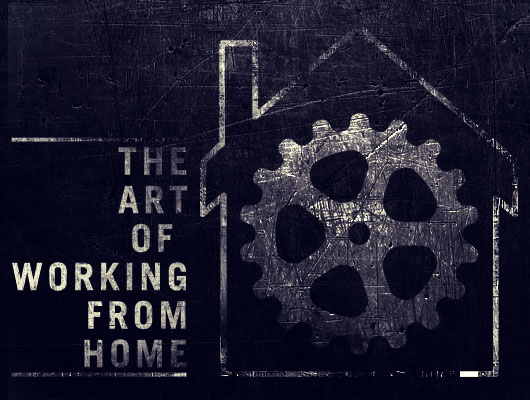There’s a certain mythology about working from home with the white collar set. Office workers and cubicle drones will pine about “how awesome it would be” and curse telecommuters for how “lucky” they are. When surveyed about 80 % of American workers say they’d rather do their jobs from home. If you’ve ever worked in an office environment, you’ll understand the sentiment. Being able to do one’s job and not have to deal with the annoyances of commuting and co-workers is pretty appealing. And if you don’t agree, just wait until Janet from accounting starts sending those emails to everyone about whoever keeps stealing her Greek yogurt out of the break room fridge.
The fact is that more and more people are working from home these days. According to recent stats, 13.4 million people telecommute in the United States. That’s a jump of just over 40% in the last ten years. It’s estimated that 9.5% of all American workers work at least one day a week from home. The increase makes sense with the rise in home Internet usage, applications like Skype that make teleconferencing easier, and the need for companies to lower their overhead in this economy. But all is not well in the world of telecommuting.
Just two months ago, working from home was in the news when Yahoo! CEO Marissa Mayer caused a bit of a stir by decreeing the end of telecommuting for the Internet giant. According to reports, Mayer’s decision was based on discovering that Yahoo! employees who work from home were not logging in enough to the company’s private network. Meanwhile, Best Buy, which was one of the first corporations to embrace telecommuting as an option for its employees, announced that it too was changing its work-from-home policy, though not as drastically as Yahoo!. Now, instead of automatically having the option to telecommute the electronic retailer’s non-store staff will have to get the okay from a manager first.
There’s no confirmation that Best Buy’s decision was motivated by the same reasoning that led to Mayer’s call over at Yahoo!, but it probably was. It’s hard to work from home. Telecommuting is a different beast than working in an office. Work relationships change drastically. Communication with managers and coworkers need constant upkeep. Productivity and focus can be tough be to keep up. And burnout can come quick.
Everyone thinks they can do it, but you have to know how to work from home. And more than likely it’s going to be part of your future job description.
“The Yahoo and Best Buy bans on telework are definitely the exception to the trend,” says Michael Haaren, author of two books on working from home, The 2-Second Commute and Work at Home Now, and co-director of the work-at-home jobs site RatRaceRebellion.com. Haaren cites huge names in business like Apple, American Express, and Amazon that allow its employee to telecommute. “We are also seeing growing numbers of Fortune 500s hiring home-based employees,” he adds.
But it’s not just the big established companies that are hiring work-from-homers. According to Leslie Truex, author of The Work-At-Home Success Bible and owner of one of the web’s first telecommuting online resource WorkAtHomeSuccess.com, a lot of businesses that are just starting out find that allowing its employees to work from home saves money. “Ultimately, telecommuting is allowed because it increases the bottom line,” she explains. “I see the trend toward telecommuting more with newer and smaller companies than traditional companies.”
So in order to help you, the future telecommuter, Haaren and Truex have helped us create these five basic truths about working from home.
Treat Your Home Office Like a Real Office
The big appeal for a lot of people who want to work from home is right there in the phrase. You’re working…from home. But that’s also the biggest problem. The separation of one’s home life from their work life is a benefit physical commuters don’t realize they have until it’s gone. Either all the fun stuff you keep in your house is going to distract you from getting any work done or you’ll get sucked into doing stuff for your job that you’ll be consumed by work stress. That’s why you have to act as if your home office is a real office.
As Truex explains, creating an area in your home where you’ll work (and only work) will help you focus on your job responsibilities. “Set up a distinct office or physical boundaries to designate work and home space,” she advises. “Have all the needed work items available in your work area. This includes files, phone, equipment and other tools and resources you need to get the job done.”
According to Haaren, a separate work area will also help keep you from burning out, a common problem for first time telecommuters. “Working in the bedroom is the worst,” he warns, “because you literally go to sleep and wake up with ‘the job’ on your mind.“ Haaren recommends having a space that you’re able to “shut the door” on when you’re done. “At the end of the workday, leave it and don't return until your next round of work,” he explains.
Haaren also suggests that telecommuters try to stick to a professional dress code even if their only officemate is their pet cat. “Don't dress in slothwear such as pajamas or sweats,” he says.“Lazy clothes foster unfocused thinking.”
Structure and Routine
The key to getting through any major life change is creating a rigorous routine and sticking to it. It works for quitting bad habits, getting in shape, and learning how to telecommute successfully. “Having structure and boundaries in your work-at-home life is always a good idea,” says Haaren. “Many new teleworkers lose focus and momentum because they're unprepared to be on their own in a home environment. They struggle to impose the structure that commute-and-cube naturally offer.”
One trick Haaren suggests to help impose that structure is creating “mini-deadlines” throughout the day, like aiming to get the report that’s due at 5 PM done by 2. “This will safeguard your productivity and momentum,” he explains.
Haaren also recommends staying off “time corrupters” like Facebook and Twitter, just like you would at a conventional office (Yeah….just like a that. Or maybe just at the same level you would with the danger of a boss walking up from behind and spotting you mid-tweet).
For Truex, the use of routine and schedules are great to help teleworkers stay focused, especially when tailored to the their own specific work styles. “What’s ideal about working at home is that often you can create a routine and schedule around your peak work hours,” she explains. So if you’re a strong worker in the morning but usually drop in energy and focus in the afternoon, then you should schedule your work activities that require the most concentration and mental acuity in the morning, and vice versa.
Get Out of the House Now and Then
As much as sticking to routine structure in your home office can help you stay productive, it still won’t replace all the dynamic benefits that come with physically going to an office. That’s why it’s important to get out of the house.
Working alone in a home office can grow stifling pretty quickly. Think Jack Nicholson in The Shining. So to keep the walls from feeling like they’re closing in and you’re chasing your girlfriend with an axe, Haaren advises taking regular pauses throughout the day and enjoying the outside world. “Take exercise breaks,” he suggests. “Walk the dog, get some fresh air.”
Another reason to get out of your home office? Connecting with your workers at physical meet-ups. “These provide an alternate workspace, camaraderie, and networking,” explains Haaren. “Consider using a co-working center periodically,” he adds. “Keep the habit of going into the professional office regularly, if you can. Hybrid teleworking models often work best. No need to impose an ‘all or nothing’ arrangement if it isn't necessary
Just Because You Work from Home Doesn’t Mean You’re Home
Everyone runs errands and deals with the occasional personal issue during a workday. Sometimes that means picking up the dry cleaning while on a lunch break or calling from the office line to schedule a doctor’s appointment. But it’s different for those who work from home since they’re surrounded by personal stuff that needs to be taken care of all the time. For telecommuters, housework and chores can become an excuse to shirk off from work. I need to write this memo…as soon as I finish washing the dishes.
“Avoid frequently alternating between work and home time,” says Truex, “although this is one of the benefits of working at home. You can’t expect to get the focus and quality needed alternating between [housework] and working.” And it’s not even just your personal matters that could end up distracting you, since as a work-from-homer you’re the envy of others. “Friends and family think you’re available at any time to run their errands or let the cable guy in,” warns Truex.
It’s a sentiment echoed by Haaren, who advises that telecommuters “remind friends and family that working from home doesn't mean ‘available at home.’” He also suggests adopting the more severe personal policy of not answering non-work emails, texts, or calls during worktime.
Stay Connected with Your Company and Career
Finally, it’s important to avoid one of the classic pitfalls of telecommuting: going it alone. Just because you work by yourself at home doesn’t mean you need to become a loner, in fact both Haaren and Truex recommended keeping in touch with coworkers, team members, and supervisors. For Truex, letting others, especially those directly above you in the command chain, know your schedule will keep everyone on the same page in regard to your commitments. “Sometimes the boss thinks you can work after hours since your office is in your home,” she explains.
While for Haaren, the constant contact and updating maintains focus. “[It] will remind you of your commitments and deadlines, and the consequences of underperforming,” he says.


















